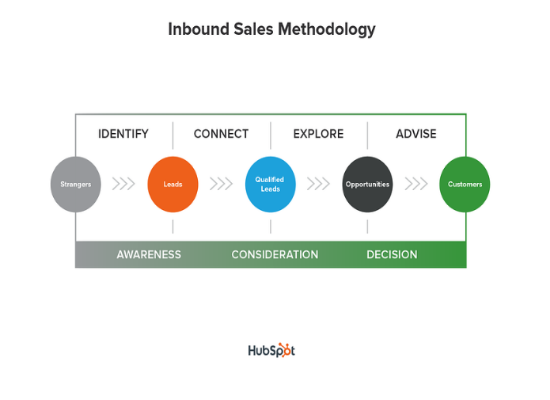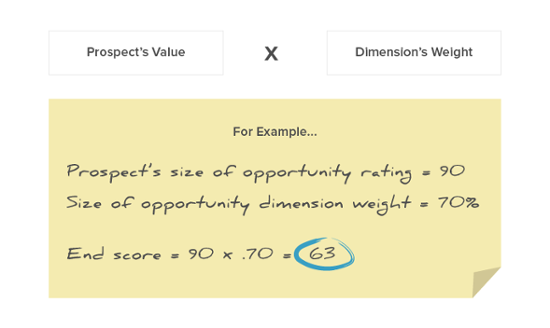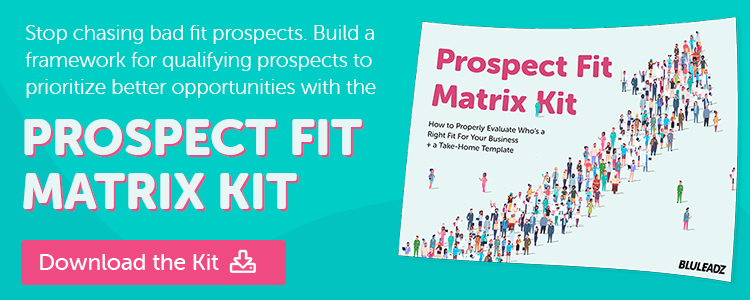Picture it. The pipelines sit empty. Your sales leadership is pointing at the clock.
The question looms over your head.
Are you on pace to meet your quota?
This is the stress of today’s salespeople. And, hate to say it, but your pipeline isn’t going to fix itself either.
Your solution lies in building a strategy for sales prospecting.
What Is Sales Prospecting?
Sales prospecting is the active process of searching for potential customers to drive your business forward and generate revenue. Ultimately, you’re aiming to guide your target through the sales process to eventually close as customers.
Prospecting plays an active role in the inbound sales methodology, aiding in the search of leads and prospects.

Source: HubSpot
To refresh:
- A lead is someone who has expressed interest in your company by visiting your site, downloading a content offer, or subscribing to a blog.
- A prospect is the term for when a lead is qualified against your prospect fit matrix and buyer personas. Essentially, a lead becomes a prospect when they fit your ideal customer.
Leads and prospects often times get confused. A lead is a contact that has interacted with your brand, but has not been qualified (yet). Typically in sales, you gather leads first, qualify those leads, turn them into prospects and move them through your sales process.
Now that you’ve learned what sales prospecting is and how it can impact the inbound sales process, you’re ready to build your strategy.
Building a Prospecting Strategy
The end goal of your strategy should be to move potential customers through the sales cycle to purchase your product or service. It’s a long process to move down that funnel though, and understanding that process is essential so that you don’t plan an ineffective strategy.
Let's breakdown the framework of sales prospecting and show how your strategy fits into it.
1. Research
The top of the sales funnel requires research. You’re evaluating the quality of a lead. Lead qualification requires a set of criteria to assess their likelihood of becoming a customer.
During this step, your CRM should be your best friend. With it, you can track each lead or prospect and identify the stage that they’re in within the sales cycle.
Depending on the circumstance, you might have some important information. For example, if a visitor filled out a form to download an ebook, your CRM will have the form's answers in it. Those questions might reveal important information, like the size of their company and the amount of revenue they generate.
Essentially, before you can move onto prioritizing your outreach, you need to make sure you can connect with your prospect and what the best approach would be.
You need qualifying dimensions in the beginning. These dimensions include:
Organizational Fit
This is based on demographics, like the prospect's industry or buyer persona, and it will reveal the overall size of the opportunity and their potential lifetime value.
Key Stakeholders
This is a list of influencers and decision makers mapped to the prospect's organizational structure. You can actively research the company to build this list, which you will use during the outreach stage.
Familiarity Level
This indicates how well versed you and your sales team are with the prospect's industry, market, services offerings. etc. The more familiar your team is, the higher you should score them as a priority.
Awareness Level
This shows how aware the prospect is with your company and products/services. If they're more aware, they're more likely to become customers.
Deal Breakers
This defines any budget or time constraints that can influence whether or not they're worth pursuing.
These qualifying dimensions influence how you can prioritize each prospect.
2. Prioritize
This step will help you organize prospects into high, medium, and low categories. You can use lead management software to automate parts of this process, like calculating lead scores.
The qualifying dimensions listed above need to be broken down to a number between 1 and 100 percent. Then, assign a value between 1 and 100 for each dimension per prospect.
Finally, you need to multiply the value of the prospect by the weight of the dimension.

Source: HubSpot
Now, you can add up each dimension score so each prospect receives a total score. This leaves you with a list of scored prospects, which you can use to prioritize where to start your outreach.
3. Plan Outreach
Now, you're ready to dig deeper and plan how you can interact directly with a lead or prospect. You can dive deeper into each prospect to identify what they care about, which you can find in their social presence, company website, and blog.
After finding what they care about, you determine who to reach out and what the reason for that connection would be.
You can connect with a gatekeeper. This is the person in charge of managing communications for a decision maker, like a personal assistant or receptionist.
Once you know who is in what role, you can use your research to personalize your outreach messaging.
Building a rapport and relationship with both the gatekeeper and decision maker is important to the sale, so you need to know what makes them tick.
You can also analyze your competitors to see how you can better position yourself to the prospect during the first touchpoint.
4. Connect
This is the big moment – the chance for sales to make a solid impression on the decision maker or influencer you select to start the conversation with.
When you determine how you want to conduct your first outreach, whether that be email or phone, keep a few best practices in mind:
- Personalize it: Use their name. Build rapport. Speak using specifics to show you understand them.
- Be a helper, not a pusher: Remember that you’re consulting in an attempt to provide them value. It’s about them and their needs, not you and your quota.
- Be timely: Ensure you’re making contact quickly so the problems you speak on are still relevant to their current situation.
- Stay casual: Don’t forget to stay cool. Remember, you’re just having a conversation. It will be obvious if you’re reciting a script and being impersonal. Like any other deal, you’re simply two people determining whether or not both parties receive mutual benefits from the relationship.
A positive first impression should then lead to a discovery call.
There are certain goals you want to keep in mind and accomplish when connecting for a discovery call. This is where qualifications come in handy.
One of the best frameworks to follow would be CGP TCI BA. This breaks qualifications down into three levels:
- Challenges, Goals, Plans
- Timeline, Consequences, Implications
- Budget and Authority
This framework helps guide the conversation smoothly to better understand the whole situation, from their goals to who is in charge of the decision.
5. Educate and Assess
Here, sales teams should zero in on pain points and assess a prospect’s objections standing in the way of their decision to purchase.
Address their concerns when you follow up after the discovery call and offer all the necessary information about your brand that can wipe away their hesitation.
6. Close
Finally, this is your chance to score the goal and bring it home for the team. You’re ready to turn this opportunity into a customer and it can go one of two ways:
- Closed-won – the buyer makes the purchase.
- Closed-lost – the buyer does not make the purchase.
This is what the sales process looks like. An effective strategy that you build around this should include various prospecting techniques.
Sales Prospecting Techniques
With strategy in mind, it’s important to know some key techniques that can be implemented into it. You can basically break down prospecting into two groups: inbound techniques and outbound techniques.
Inbound Prospecting
The inbound methodology fosters a more personalized outreach. For example, a lead downloads a content offer your company provides. You can address what their pain point is from the get go, depending on the topic of the content offer. It’s a bit more friendly with the ice already broken.
Inbound prospecting includes:
- Social selling: Through social media, you can build a relationship with a lead who is already familiar with your company’s services. As a sales rep, you can offer value over the same social channels through helpful content and interacting directly with comments and questions.
- Warm email: This is kind of the same thing as social selling, but over email rather than social media. It’s a more direct form of contact where you have space to be warm, engaging, and start the relationship off strong.
Outbound Prospecting
Outbound practices require you to reach out to leads and prospects a bit more in the dark. You may not have any prior history with the contact, forcing you to engage without much context.
Outbound prospecting includes:
- Cold calling: These are unsolicited calls to sell your product or service. Granted, it’s a bit more awkward, but there are ways around the dreaded “Sorry to bother you” line. One approach you can take is letting the contact know of the companies similar to their own that you may have worked with.
- Social connections: This is cold calling over social media. You can reach out to your prospect’s media accounts to start the conversation. One perk of this technique is that you have the opportunity to qualify the prospect by performing a quick scan of the content they like and post on social media.
Both techniques will get the ball rolling for you, but inbound prospecting takes some of the pressure off of the outreach aspect of sales.
But maybe you’re not easily dissuaded and cold calling is the way to go for you. Play to your strengths as a salesperson and implement the methodologies that are going to drive success for you and your company.
The Best Prospecting Tools
In today’s digital world, there are so many tools available that can aid the prospecting process. Here’s a few to give you an idea:
- CRM: Use this management system to store contact info, track deals, and manage tasks.
- Twitter: An excellent way to sift through prospect information to find what’s important to them.
- Google Alerts: Track relevant keywords that relate to your prospect to personalize outreach.
- LinkedIn: Take the time to study your prospect’s company pages and learn about their culture so you can tailor their sales cycle.
- Datanyze: Track what tech prospects are using and look for opportunities or indicators that they are changing services. If you’re a SaaS company, you can step in and offer your own software as a solution.
Now you’re ready. You’ve got a proper game plan. You’re pumped and focused. You can answer the question with confidence. Get out there and start crushing your quota the right way with sales prospecting.


Micah Lally
I’m a Content Writer at Bluleadz. I’m a big fan of books, movies, music, video games, and the ocean. It sounds impossible to do all of those at the same time, but you’d be surprised by the things I can accomplish.